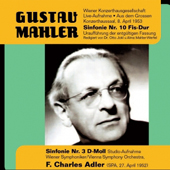
ESSENTIAL RECORDINGS

Symphony No. 3 (SPA Records studio recording, April 27, 1952)
Symphony No. 10 (Live performance recording premičre of the first published version 'Dr. Otto Jokl edition', April 8, 1953, movements 1 and 3 only)
The now legendary, 60 year old Charles Adler studio recording with the Vienna Symphony Orchestra of the
Symphony No. 3 by Gustav Mahler, has once again been re-issued with broad distribution to the general market, with
sound restorations done by A. Z. Snyder in 2010. This pioneering interpretation has always been highly respected and recognized as one of the best and most
idiosyncratic versions ever recorded. It set the bar for all other conductors to follow. Only seven days prior to this recording, Adler had conducted the Vienna
Symphony Orchestra, alto Hildegard Rössl-Majdan, the Vienna Women's Choir and the Vienna Boys Choir in a broadcast performance for Austrian Radio. Therefore
with these forces completely rehearsed, he led this recording for SPA (a record label he co-founded), which was completed in one single day on April 27, 1952.
Because this was one of the very first recordings of this symphony, and of any Mahler symphony for that matter, Charles Adler had carte blanche
over its interpretation, and took full advantage of that opportunity. The first movement in particular has a scope, a far reaching grasp, that has often been
copied, but never quite matched. The inner orchestral movements clearly demonstrate why the Vienna Symphony Orchestra has always been considered one of
the top ensembles in the world, with each section of the orchestra constantly setting the bar for the next to follow, particularly remarkable in the third movement.
Alto Hildegard Rössl-Majdan provides a touching rendition of the setting to the text in the fourth movement, and the Vienna
Boys Choir bring the proper angelic sound to the text in the fifth. In one of the slowest interpretations, at just over 26 minutes, of the final movement,
Adler delivers a truly Mahlerian experience of one of this composer's most inspired moments. The extended crescendo that begins at the 24:15 mark is simply
astounding in its control and dynamic power.
The Krenek version, with additions by Zemlinsky and Schalk, edited by Otto Jokl for publication, is the score of the Symphony No. 10
used in this live recording, issued here for the very first time. It clearly demonstrates the curiosity and interest that conductors of Adler's stature brought to this
unfinished work. Even though this was one of the very early accounts of this symphony, Adler demonstrates a confidence and deep understanding of Mahler's
intent.
The sound quality in this Music and Arts restoration of this 60 year old mono recording is quite remarkable. Aside from some rare moments
of a slight bit of congestion in the louder passages, this recording certainly does not reveal its age. If you have missed the opportunity to acquire this iconic
recording in the past throughout its many reincarnations and reissues, now is your chance to obtain a copy. The booklet notes are detailed and informative, and
even include pictures of the original jacket covers and concert programs, along with extensive and informative footnotes.
Jean-Yves Duperron - April 2011